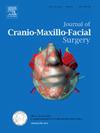CAD/CAM surgical guides and pre-bent distractors: Enhancing precision in MDO for severe dentofacial deformities secondary to TMJ ankylosis
IF 2.1
2区 医学
Q2 DENTISTRY, ORAL SURGERY & MEDICINE
引用次数: 0
Abstract
Background
This study aimed to compare the different outcomes of mandibular distraction osteogenesis (MDO) using computer-aided design and manufacturing (CAD/CAM) surgical guides accompanied by pre-bent distractors versus CAD/CAM surgical guides with commercial distractors.
Methods
Twenty-eight patients with severe dentofacial deformities secondary to unilateral temporomandibular joint ankylosis (TMJA) were retrospectively enrolled. Ten parameters associated with MDO were measured preoperatively, virtually, and postoperatively. The hard-tissue digital model was reconstructed using Mimics Research 17.0, and imaging data were collected and analyzed using Freeform Plus software 12.0, Geomagic Studio 12.0, and IBM SPSS Version 20.0.
Results
Twenty-eight patients underwent MDO with subsequent adjunctive surgery and were evaluated. Thirteen patients underwent CAD/CAM surgical guides with pre-bent distractors (group A), while fifteen underwent CAD/CAM guides with commercial distractors (group B). Both techniques achieved optimal occlusion and satisfactory appearance. Statistical analysis showed group A demonstrated a more accurate control of vector direction during MDO compared to group B (p < 0.05). Additionally, group A also exhibited a shorter subsequent treatment duration and less relapse compared to group B (p < 0.05).
Conclusions
CAD/CAM surgical guides with pre-bent distractors can significantly enhance surgical accuracy in controlling the vector direction of MDO for correcting dentofacial deformities secondary to TMJA, leading to a reduction in subsequent treatment duration and occurrence.
CAD/CAM手术导向器和预弯曲牵引器:提高MDO对严重牙面畸形继发于TMJ强直的精度。
背景:本研究旨在比较使用计算机辅助设计和制造(CAD/CAM)手术导向伴预弯曲牵张器与CAD/CAM手术导向伴商业牵张器的下颌牵张成骨(MDO)的不同结果。方法:回顾性分析28例单侧颞下颌关节强直(TMJA)继发严重牙面畸形患者。术前、虚拟和术后测量与MDO相关的10个参数。使用Mimics Research 17.0软件重建硬组织数字模型,使用Freeform Plus 12.0软件、Geomagic Studio 12.0软件和IBM SPSS Version 20.0软件收集和分析成像数据。结果:28例患者接受了MDO并进行了辅助手术。13例患者接受了CAD/CAM手术导具和预弯曲牵张器(A组),15例患者接受了CAD/CAM导具和商业牵张器(B组)。两种技术都获得了最佳的咬合和满意的外观。统计分析显示,A组在MDO过程中对矢量方向的控制比B组更准确(p)。结论:CAD/CAM手术导具配合预弯曲牵张器可显著提高MDO矫正牙面继发性畸形的手术精度,减少后续治疗时间和发生率。
本文章由计算机程序翻译,如有差异,请以英文原文为准。
求助全文
约1分钟内获得全文
求助全文
来源期刊
CiteScore
5.20
自引率
22.60%
发文量
117
审稿时长
70 days
期刊介绍:
The Journal of Cranio-Maxillofacial Surgery publishes articles covering all aspects of surgery of the head, face and jaw. Specific topics covered recently have included:
• Distraction osteogenesis
• Synthetic bone substitutes
• Fibroblast growth factors
• Fetal wound healing
• Skull base surgery
• Computer-assisted surgery
• Vascularized bone grafts

 求助内容:
求助内容: 应助结果提醒方式:
应助结果提醒方式:


